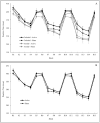Using high-definition transcranial direct current stimulation to investigate the role of the dorsolateral prefrontal cortex in explicit sequence learning
- PMID: 33735211
- PMCID: PMC7971701
- DOI: 10.1371/journal.pone.0246849
Using high-definition transcranial direct current stimulation to investigate the role of the dorsolateral prefrontal cortex in explicit sequence learning
Abstract
Though we have a general understanding of the brain areas involved in motor sequence learning, there is more to discover about the neural mechanisms underlying skill acquisition. Skill acquisition may be subserved, in part, by interactions between the cerebellum and prefrontal cortex through a cerebello-thalamo-prefrontal network. In prior work, we investigated this network by targeting the cerebellum; here, we explored the consequence of stimulating the dorsolateral prefrontal cortex using high-definition transcranial direct current stimulation (HD-tDCS) before administering an explicit motor sequence learning paradigm. Using a mixed within- and between- subjects design, we employed anodal (n = 24) and cathodal (n = 25) HD-tDCS (relative to sham) to temporarily alter brain function and examine effects on skill acquisition. The results indicate that both anodal and cathodal prefrontal stimulation impedes motor sequence learning, relative to sham. These findings suggest an overall negative influence of active prefrontal stimulation on the acquisition of a sequential pattern of finger movements. Collectively, this provides novel insight on the role of the dorsolateral prefrontal cortex in initial skill acquisition, when cognitive processes such as working memory are used. Exploring methods that may improve motor learning is important in developing therapeutic strategies for motor-related diseases and rehabilitation.
Conflict of interest statement
The authors have declared that no competing interests exist.
Figures




Similar articles
-
Effects of cerebellar transcranial direct current stimulation on the cognitive stage of sequence learning.J Neurophysiol. 2019 Aug 1;122(2):490-499. doi: 10.1152/jn.00036.2019. Epub 2019 Jun 5. J Neurophysiol. 2019. PMID: 31166807
-
Differential effects of left and right prefrontal cortex anodal transcranial direct current stimulation during probabilistic sequence learning.J Neurophysiol. 2019 May 1;121(5):1906-1916. doi: 10.1152/jn.00795.2018. Epub 2019 Mar 27. J Neurophysiol. 2019. PMID: 30917064 Clinical Trial.
-
The Polarity-Specific Nature of Single-Session High-definition Transcranial Direct Current Stimulation to the Cerebellum and Prefrontal Cortex on Motor and Non-motor Task Performance.Cerebellum. 2021 Aug;20(4):569-583. doi: 10.1007/s12311-021-01235-w. Epub 2021 Feb 5. Cerebellum. 2021. PMID: 33544371
-
Prefrontal but not cerebellar tDCS attenuates renewal of extinguished conditioned eyeblink responses.Neurobiol Learn Mem. 2020 Apr;170:107137. doi: 10.1016/j.nlm.2019.107137. Epub 2019 Dec 12. Neurobiol Learn Mem. 2020. PMID: 31838223 Review.
-
Brain stimulation for combating Alzheimer's disease.Front Neurol. 2014 Jun 2;5:80. doi: 10.3389/fneur.2014.00080. eCollection 2014. Front Neurol. 2014. PMID: 24917846 Free PMC article. Review. No abstract available.
Cited by
-
Comparing the effects of focal and conventional tDCS on motor skill learning: A proof of principle study.Neurosci Res. 2022 May;178:83-86. doi: 10.1016/j.neures.2022.01.006. Epub 2022 Feb 3. Neurosci Res. 2022. PMID: 35123828 Free PMC article.
-
Towards optimized methodological parameters for maximizing the behavioral effects of transcranial direct current stimulation.Front Hum Neurosci. 2024 Jul 2;18:1305446. doi: 10.3389/fnhum.2024.1305446. eCollection 2024. Front Hum Neurosci. 2024. PMID: 39015825 Free PMC article.
-
The polarity of high-definition transcranial direct current stimulation affects the planning and execution of movement sequences.Neuroimage. 2025 Feb 1;306:121018. doi: 10.1016/j.neuroimage.2025.121018. Epub 2025 Jan 10. Neuroimage. 2025. PMID: 39800171 Free PMC article.
References
MeSH terms
LinkOut - more resources
Full Text Sources
Other Literature Sources

